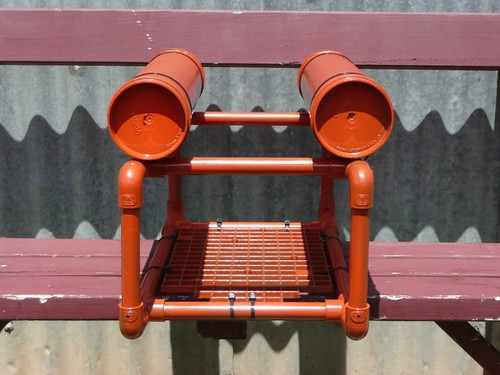Progress on ROV construction
Published: November 10, 2010Tags: rov
A few weekends ago I got the chance to do some construction work on my ROV project. I've upload some pictures to Flickr. Here's one of the assembled and painted body:

and here's another showing the bilge pump mounted to the grid on the base of the body:

A few tips for other people building ROVs in (South) Australia:
- Most ROVs on the web build the mounting grid out of a plastic grid material which is commonly used for two things, diffusing light from fluorescent tubes, or diffusing air flowing out of an air conditioning duct. It seems that this stuff is common and easy to find in the US, but I had a bit of trouble finding it here. Major hardware chains like Bunnings don't seem to carry it. I had no luck learning where I could get this searching online for things like "plastic diffuser grid". The breakthrough came when I learned that this stuff is called "eggcrate" (I was baffled as to why until I found a photo of an old time egg crate, which bears no resemblence to the cardboard cartons you buy eggs in today). I called a few plastic supply places around Adelaide, including City Plastics, Acrilix Plastics and Menzel Plastic Traders. All of them knew exactly what I meant when I asked about "eggcrate" and they all sold it. It comes in sheets which are (from memory) about 120 cm tall and 60 cm wide, and these sheets cost between $30 and $40 at the places linked to above. One of these sheets should be enough for a few ROV projects if you're careful with it, so the per-ROV price is even cheaper. I also read online that you can sometimes buy eggcrate at aquarium supply stores, because people use it to make breathable lids for fish tanks. I asked a friend who worked at a pet store if she knew anything about this and she didn't, but it wasn't a dedicated fish store, so you might have better luck at such a place. In the end, I didn't end up using eggcrate at all, because a friend of a friend was able to get me some old bread crates (the kind used in bakeries) which worked well enough.
- The two places I've found which sell bilge pumps of the kind commonly used for ROV projects are Super Cheap Auto (I haven't looked for one in-store, but you can find them easily enough on their website) and Boating Camping Fishing (and I have bought a pump in-store from my local BCF, and they had a pretty good range). I tried a Ray's Outdoors but they didn't have any.
I'm leaving quite soon for a one month long trip (culminating in the Neural Information Processing Systems conference in Vancouver in December!), so I won't get a chance to do any more ROV work for a little while, but before I leave I'm hoping to get the chance to do a quick bathtub test of what I've built so far. If all goes well, upon my return I'll buy the 3 other bilge pumps I need to get adequate control and then things should progress fairly quickly!